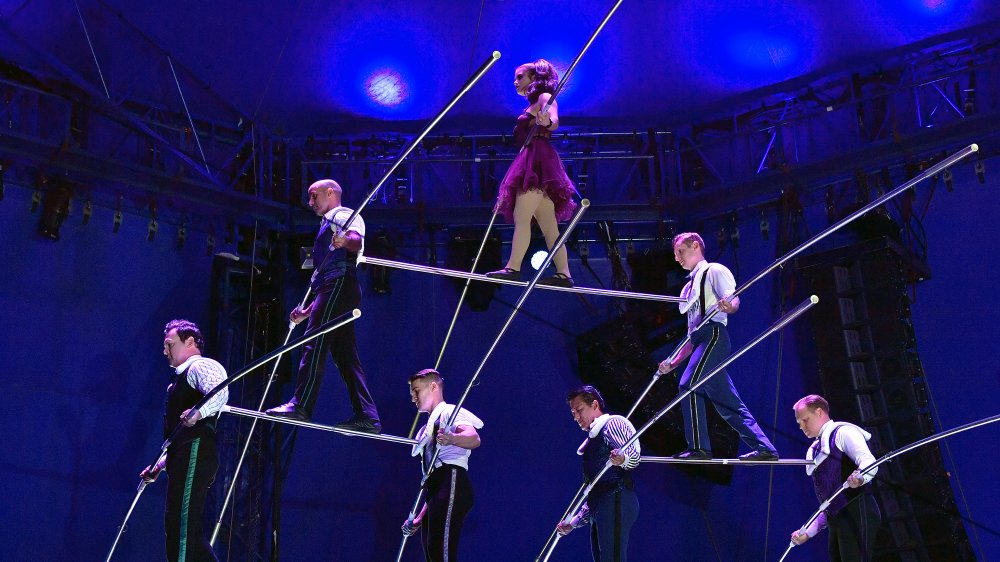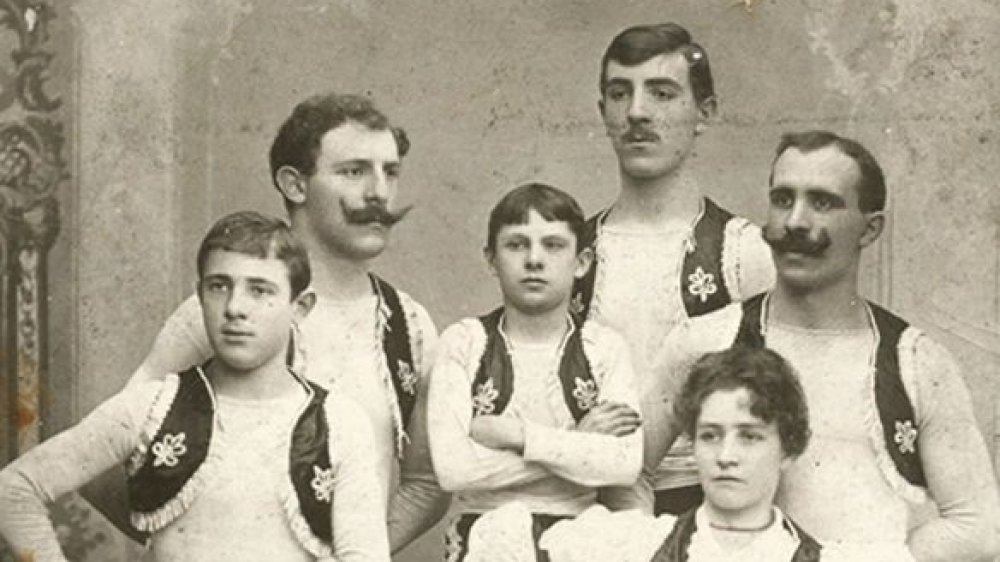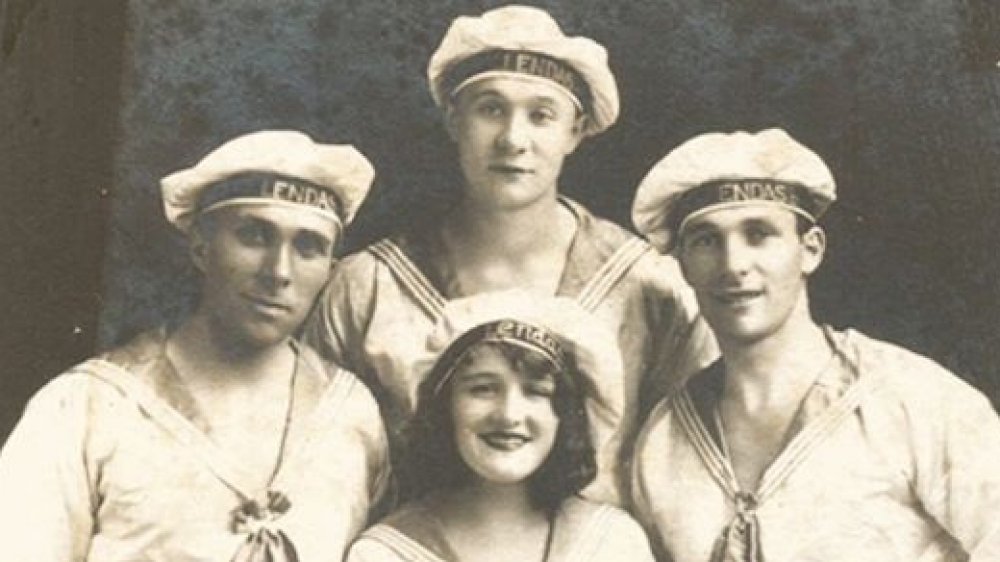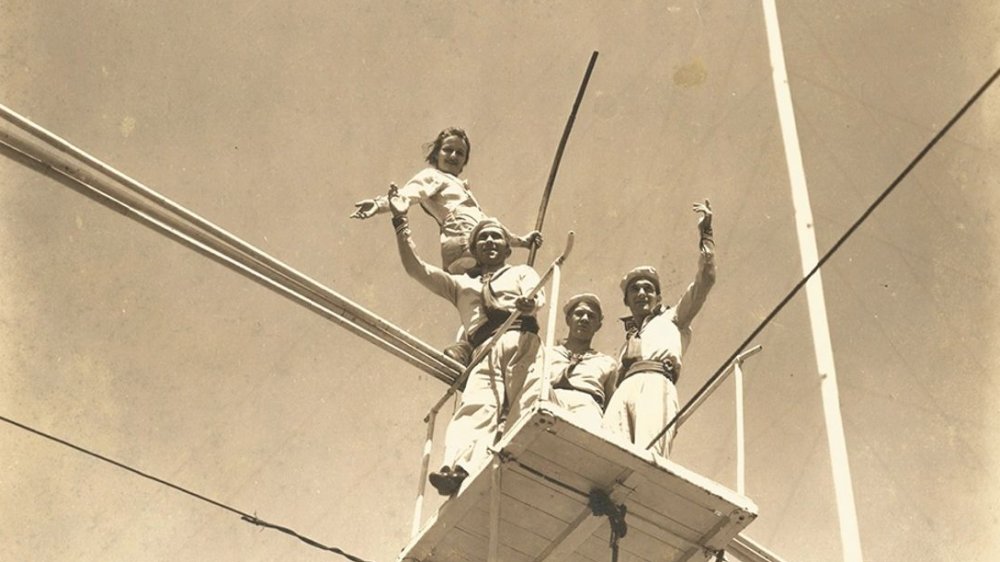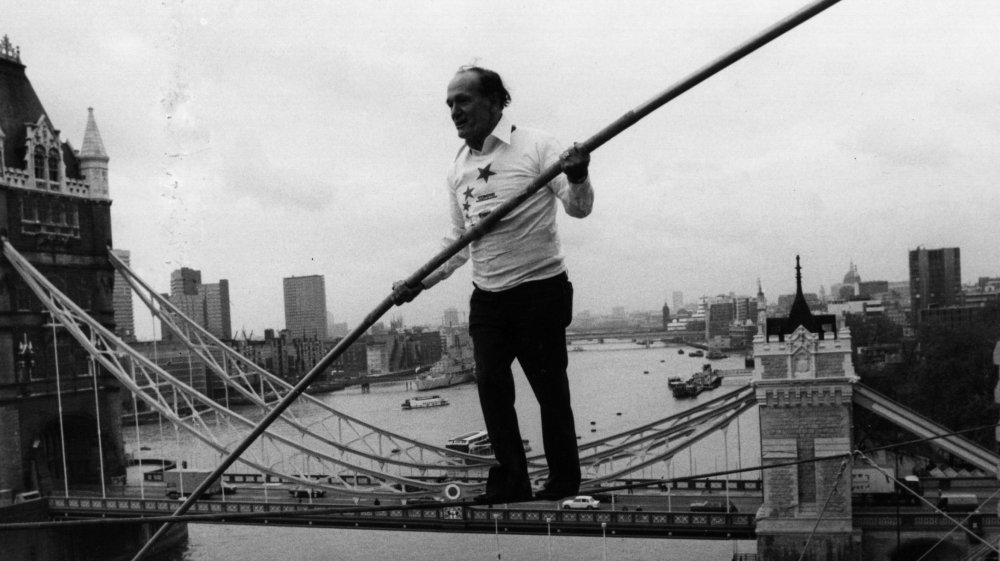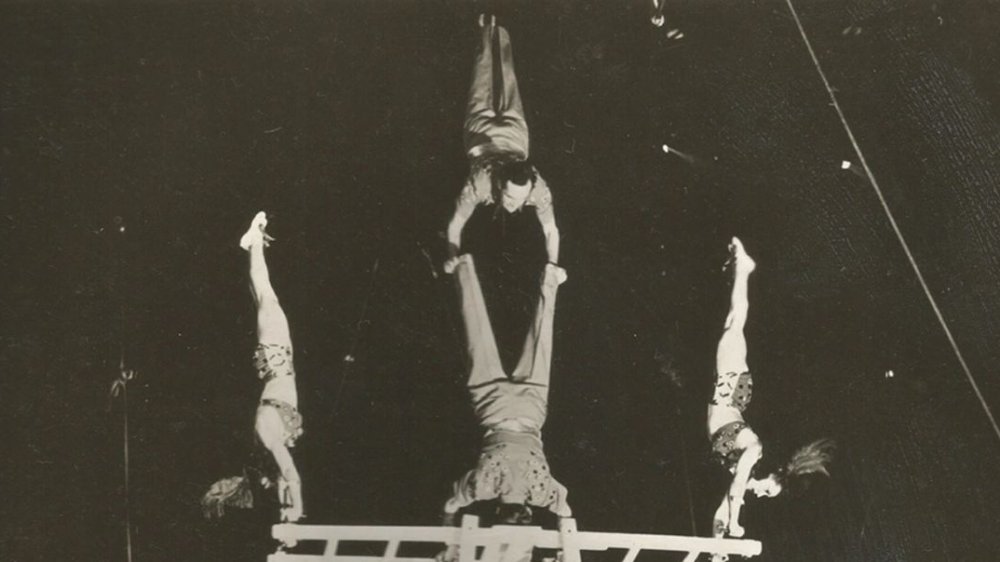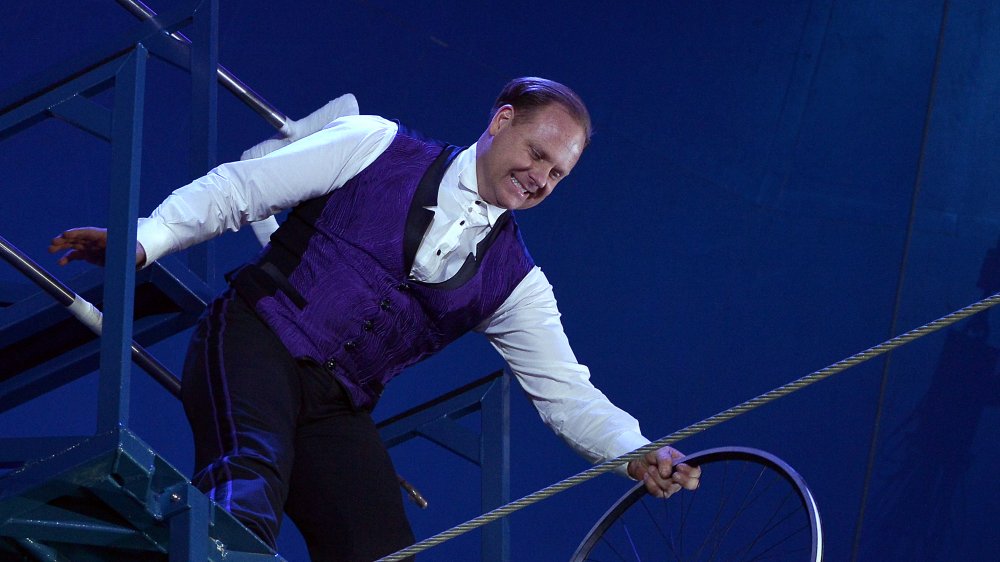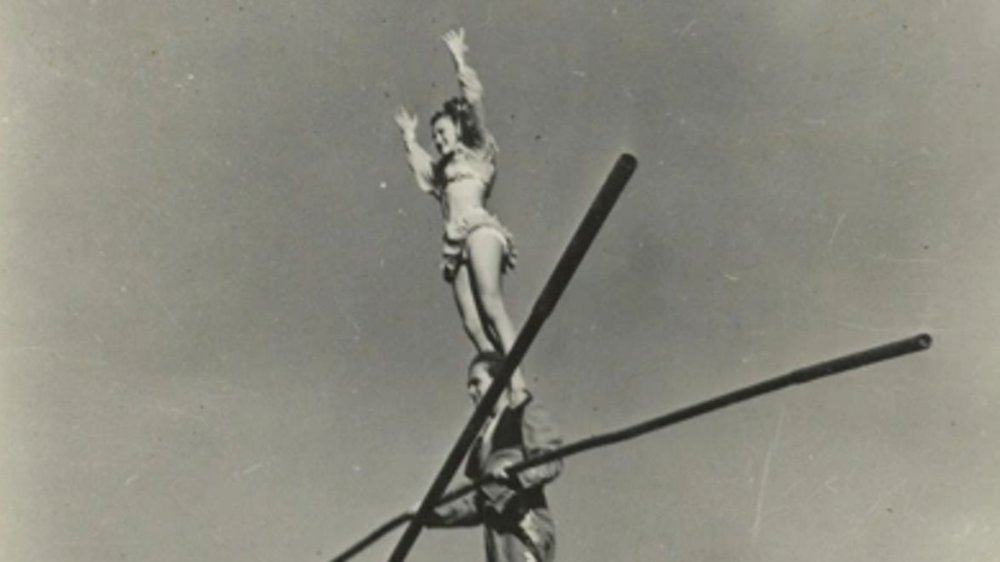The Flying Wallendas: The Truth About The Daredevil Family
Renowned aerialists the Flying Wallendas just might be the most iconic performers in circus history. With a lineage that spans centuries and countless news headlines to their name, they've certainly built a legacy for themselves. Members of the famous family have invented daring new acts, crossed waterfalls and canyons stories above the ground, toured with America's biggest circus show, and broken several world records. They've appeared on a variety of TV programs and performed all over the globe. Yet their road to international recognition hasn't been easy.
Over the decades, the Wallendas have experienced all kinds of hardships, including injuries, deaths, and fallings-out between relatives. Many people in their position would have left the industry years ago, but that's never even been a consideration for them. To this day, the family continues to perform shocking stunts for audiences all around the world, driven by a genuine passion for thrill-seeking. Here are some of the most fascinating facts about these legendary entertainers.
The Wallendas' story starts in the 1780s
According to a biography on the Wallendas' website, the story of the famous family stretches all the way back to Old Bohemia, circa 1780. Back then, the Wallendas traveled around the Austro-Hungarian Empire as a circus troupe, performing in cafes and city squares. Their ranks included all types of entertainers, from acrobats to jugglers to clowns to aerialists to animal trainers. They eventually became recognized for their flying trapeze act.
Karl Wallenda, founding member of the Flying Wallendas as we know them today, was born in Germany in 1905. At the young age of 11, he began performing in circus acts with his family at German beer halls. As a teenager, he saw a newspaper ad calling for "an experienced hand balancer with courage" and decided to answer it. This simple action changed the course of his entire life: He became the apprentice of tightrope walker Louis Weitzmann, who taught him everything he needed to know in order to become a bona fide circus superstar. In 1922, he started his own wire-walking act, joined by his brother Herman and aerialists Josef Geiger and Helen Kreis (who would eventually marry Karl and become matriarch of the fantastic Wallenda clan).
The Flying Wallendas were the stars of "The Greatest Show on Earth"
According to their official website, in their early days on the road, the Wallendas were known for performing a special act called the four-person, three-level pyramid. Two men on bicycles would pedal across a wire 50 feet in the air, carrying a bar. Karl would balance on top of this bar in a chair, and Helen would stand on his shoulders. This very stunt caught "Circus King" John Ringling's eye when he saw the Wallendas performing in Cuba in the late 1920s. Ringling was so blown away that he invited the family to be a part of his circus, which he deemed "The Greatest Show on Earth."
"The Great Wallendas" performed at the Ringling Brothers, Barnum & Bailey Circus for the first time at Madison Square Garden in 1928. As is typically a precaution during high-wire performances, they were supposed to use a safety net, but it had been misplaced in shipping, so they daringly decided to go forth without it. They performed their act without a hitch and received a 15-minute standing ovation.
The Great Wallendas continued to travel with the circus throughout the 1930s and '40s. At one show, the wire slipped as they were performing. They all fell to the wire but received no major injuries, scoring the headline "The Flying Wallendas" from a local newspaper. The name caught on and has been associated with the family ever since.
The Flying Wallendas survived the Hartford Circus Fire
Unfortunately, the Wallendas have been at the center of more than a few tragedies. One such incident was the Hartford Circus Fire, which took place on July 6, 1944. According to Connecticut History, 6,000 to 8,000 patrons were gathered at a performance of the Ringling Brothers, Barnum & Bailey circus in a field in Hartford on that fateful day. The Wallendas had just taken their positions on the high wire when the canvas of the Big Top tent caught fire. Nobody knows for sure what started the fire, but many speculate that it was the work of a fallen cigarette.
Circus attendees ran for the exits, but many of them were blocked by animal cages that were being moved out of the tent. As the fire worsened, burning patches of tent canvas began to fall from the sky. Before long, the fire had burned through the support poles of the tent, and it collapsed on the circus-goers and performers within.
According to the Wallendas' website, the aerialists were able to lower themselves to the ground and evacuate the Big Top in time. Others were not so fortunate — 168 people and many animals died in the horrific accident. The Hartford Courant reports that in 2005, a memorial honoring those who died in the fire was erected in the field where the tragedy occurred. All of the victims' names and ages are etched into stone there, to be remembered by generations to come.
The Flying Wallendas had their own signature trick
The Wallendas' website recounts that in 1947, after starting his own circus in Sarasota, Florida, Karl Wallenda invented his own show-stopping act: the seven-person chair pyramid. On the bottom row of the pyramid were four men standing on a wire 35 feet above the ground, holding two shoulder bars between them. In the middle row stood two more men, also holding a shoulder bar. At the apex of the pyramid, a woman balanced on a chair. The Wallendas performed this trick from 1948 to 1962 with no problems. They even executed it during an earthquake.
Unfortunately, in 1962, when the Flying Wallendas were performing in Detroit, the trick went horribly wrong. The pyramid collapsed, and three performers fell to the ground. According to the Sarasota Herald-Tribune, these performers were Karl's adopted son, Mario Wallenda, 21, cousin Dieter Schepp, 23, and brother-in-law Dick Faughnan, 29. Schepp and Faughnan died. Wallenda was knocked out and woke up with a concussion, a broken rib, and a broken back. He was permanently paralyzed by the accident.
According to their website, the Wallendas decided that they wouldn't let terror paralyze them after the tragedy. In 1963, they performed the trick once more, proving to themselves — and the world — that they weren't going to let anything stop them, not even the fear of death. Karl's grandchildren later recreated the stunt for a film called The Great Wallendas.
Karl Wallenda died while performing
The Wallendas' website states that Karl continued to walk the wire after the 1962 accident. In addition to performing with his family, he often did daring "Sky Walks": high-wire walks between two buildings or across stadiums, stories above the ground. On March 22, 1978, he brought his solo act to San Juan. According to The New York Times, he was crossing a 750-foot cable between the Condado Holiday Inn and the Flamboyan Hotel when he lost his balance. (The Times says that Karl apparently fell due to strong "wind gusts." The Flying Wallendas' website disputes this claim, citing "several misconnected guy ropes along the wire.") He slipped and grabbed onto the wire, but he eventually lost his grip. He then fell 100 feet and landed on top of a taxicab. After being rushed to the hospital, he was declared dead due to "multiple fractures and traumas." He was 73 years old.
The Wallendas' online biography emphasizes that Karl truly did die doing what he loved. He once said, "Life is being on the wire, everything else is just waiting."
Cancer couldn't stop Angel Wallenda from performing
Angel Wallenda, born Elizabeth "Lizzie" Pintye in 1968, has an especially remarkable life story. According to The New York Times, when she was 17, she noticed a young man admiring her at the New York City ice cream shop where she worked. Later that day, she saw a crowd gathering in a parking lot and drew closer to see what the fuss was about. To her surprise, the young man from the ice cream shop was there, walking on a high wire. That man was Steven Wallenda, Karl's nephew.
Steven noticed Lizzie and invited her to perform with him during his next show. Lizzie had zero tightrope-walking experience, but she accepted the offer and turned out to be a natural. Eventually, the two married. Steven called Lizzie "Angel," and the nickname stuck. Just after she began her formal training, however, Angel started to demonstrate signs of cancer. In 1987, her right leg was amputated. She wouldn't let that stop her, though. She continued to perform with a prosthetic limb, wowing audiences. She died in 1996, at the age of 28.
Angel hoped to inspire others to achieve their own goals, no matter how impossible they might seem. She once said, "When I'm way up in the sky, walking on a thin line with a fake leg, people look up at me and really pay attention ... They see that I'm using everything I've got to live my life the best I can."
Nik Wallenda has broken several records
Nik Wallenda, great-grandson of Karl Wallenda, is one of the better-known members of his family. According to the Chicago Tribune, he started performing in 1992, when he was only 13. He's been walking the high wire ever since.
Throughout his career, Nik has succeeded in all kinds of never-before-seen stunts. On August 4, 2001, he broke his first world record: the Guinness World Record for tallest four-person-high pyramid on a tightrope, a daring stunt that he and seven other members of his family performed 25 feet above the ground at a Japanese amusement park. On June 4, 2011, he made headlines again by crossing between two towers in San Juan, Puerto Rico, performing the exact same walk that Karl Wallenda had been attempting when he died. On June 15, 2012, he walked 1,800 feet on tightrope over Niagara Falls, becoming the first aerialist to ever cross the landmark. Just over a year later, on June 23, 2013, he set another record by crossing the Little Colorado River Gorge at a height of 1,500 feet.
Nik isn't just notorious for his tightrope-walking skills. He's known for bicycling across high wires, as well. On October 15, 2008, he set the Guinness World Record for longest tightrope crossing by bicycle, pedaling 235 feet across a high wire over New Jersey. On August 28, 2010, he broke his own record, this time cycling 238 feet over the Bahamas.
Lijana Wallenda survived an accident in 2017
One day in 2017, WWSB reports, the Flying Wallendas were rehearsing for a new stunt — an eight-person pyramid. Unfortunately, the rehearsal went terribly wrong when the pyramid collapsed. Three of the performers were able to save themselves from injury by grabbing onto the wire, but the other five fell to the ground. One of these performers was Lijana Wallenda, great-granddaughter of Karl Wallenda and sister of Nik Wallenda. Lijana broke every bone in her face and was placed in a medically induced coma.
Lijana's accident might have been horrific, but it didn't stop her from performing. According to CNN, two years later, she returned to the high wire with an especially shocking stunt. On June 23, 2019, she and Nik became the first aerialists to walk over Times Square on a tightrope 25 stories above street level. As she crossed the 1,300-foot wire, Lijana alternated between singing, chatting with Nik, and talking to her father via a communications system.
Erendira Wallenda has her own unique story
Erendira Wallenda, Nik's wife since 1999, comes from an impressive lineage of circus performers. According to Nik Wallenda's Facebook page, there are seven generations of performers on her father's side and eight generations of on her mother's. Her father's family owns a circus in Australia, while her mother's family is based in Mexico and is recognized as the first group of performers to complete a quadruple somersault on the flying trapeze.
Erendira is also a phenomenal aerialist in her own right. The Florida Times-Union recounts that in 2017, she performed a stunt that shocked the world: She hung by her teeth from a helicopter over Niagara Falls, hovering 300 feet above the water. By doing so, she broke a record previously set by Nik, who once hung by his teeth 250 feet above Silver Dollar City, a Missouri amusement park. Looking back on those moments in the air, which would be paralyzing to many, Erendira described her experience as "beautiful and amazing."
Carla Wallenda's career spanned decades
Carla Wallenda, born to Karl Wallenda and Helen Kreis in 1936, has lived quite the exciting life. According to a biography on her son Rick Wallenda's website, she made her public debut as a tightrope walker at only three years old when she appeared in the Warner Brothers newsreel "Hi Wire Lay Off with Lou Jacob and Little Carla." She spent much of her youth traveling the globe with her family as part of the Ringling Brothers, Barnum & Bailey Circus. She later performed at the Wallenda Circus. Many times, it was she who sat in the chair atop the Wallendas' infamous seven-person chair pyramid.
A Yahoo article recounts that in 2017, Steve Harvey invited Carla onto his reality show Little Big Shots: Forever Young, which profiled the remarkable talents of former child stars "ranging in age from 60 to 103." Carla, who was 81 at the time, impressed viewers by performing stunts on a pole a whopping 85 feet above the ground. Her costars on the episode included a 72-year-old opera singer and an 80-year-old tap dancer.
The Wallendas' story has been adapted many times
The story of the Flying Wallendas is quite extraordinary, so it's no wonder that it has served as the inspiration for many works of art. As of this writing, there are two films about the family: The Great Wallendas and The Show Must Go On. According to IMDb, The Great Wallendas is a 1978 made-for-TV movie starring Lloyd Bridges as Karl Wallenda, Taina Elg as Helen Wallenda, and Britt Ekland as Jenny Wallenda, Karl's daughter. It depicts the Wallendas' career in the 1960s, when the seven-person chair pyramid was their calling card. The Show Must Go On, The New York Times states, is a 2012 documentary about the Wallenda family directed by Paula Froehle. It profiles the modern-day branch of the Wallendas headed by Tino Wallenda-Zoppe, one of Karl's grandsons.
The Flying Wallendas have also been the subject of several songs. In 2009, electronic musician Andrew Weatherall released the song "Let's Do the 7 Again." Speaking to Clash about it, he said that it was about the Wallendas' brave attempt at the seven-person chair pyramid in 1963, just after the stunt had tragically failed months before. The next year, Southern rock band the Drive-By Truckers released a track called "The Flying Wallendas." The song is a surprisingly comprehensive account of the Wallendas' career, touching on John Ringling's discovery of the Wallendas in Cuba, the Wallendas' accident in Detroit, and Karl's death in San Juan.
The Flying Wallendas are still performing today
According to The New York Times, there have been several rifts in the Wallenda family over the years. Today, multiple factions of Karl's descendants perform under the Wallenda name. Nik and Lijana Wallenda continue to perform together, accompanied by Nik's wife Erendira. Another modern troupe of Wallendas is led by Tino Wallenda-Zoppe, the grandson of Karl featured in 2012 documentary The Show Must Go On. According to his website, Tino performs with his wife Olinka, a descendant of famous Czechoslovakian circus family the Valla-Bertinis, and their four children, Alida, Andrea, Aurelia, and Alessandro. They are accompanied by Alida's husband, Robinson Cortes, and friends Sacha Pavlata and Trevor McNabb. A third group of Wallendas consists of Rick Wallenda, another one of Karl's grandsons, his wife Debbie, and his sister Rietta. This group has reclaimed the old title "The Great Wallendas."
The Times reports that some of the Wallenda relatives are friendly with each other and keep in touch, while others are estranged and do not communicate. Speaking to reporter John Anderson about the situation, Tino Wallenda-Zoppe said, "There's no ill will on my part. Competition, certainly. But we all have equal access to the Wallenda lineage."
